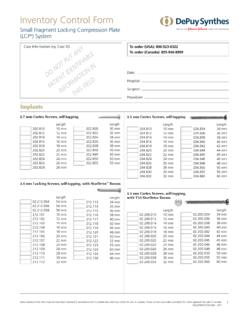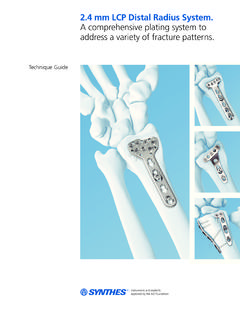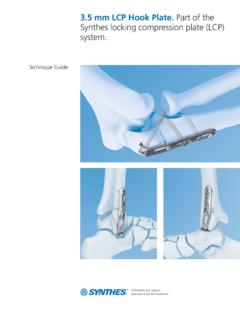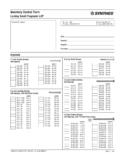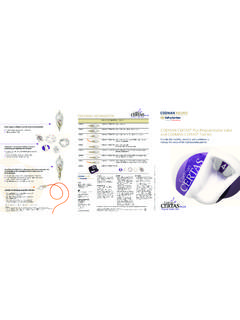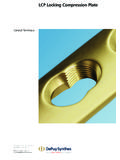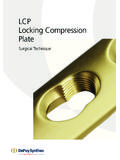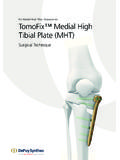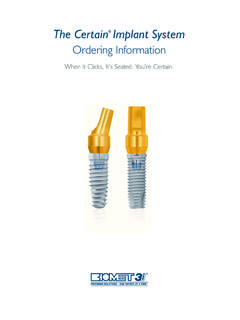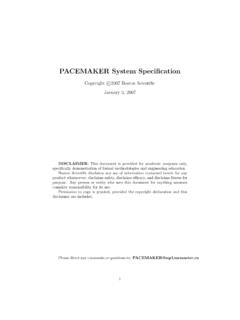Transcription of Titanium/Stainless Steel Elastic Nail System. For elastic ...
1 Titanium/Stainless Steel Elastic nail system . For Elastic stable intramedullary nailing (ESIN).Surgical Technique This publication is not intended for distribution in the and implants approved by the AO intensifier controlWarningThis description alone does not provide sufficient background for direct use of DePuy Synthes products. Instruction by a surgeon experienced in handling these products is highly , Reprocessing, Care and MaintenanceFor general guidelines, function control and dismantling of multi-part instruments, as well as processing guidelines for implants, please contact your local sales representative or refer to: general information about reprocessing, care and maintenance of Synthes reusable devices, instrument trays and cases, as well as processing of Synthes non-sterile implants, please consult the Important Information leaflet (SE_023827) or refer to.
2 Steel Elastic nail system Surgical Technique DePuy Synthes 1 Table of ContentsIntroductionSurgical Technique for Standard Indications Surgical Technique for Extended Indications Product Information Bibliography 58 MRI Information 59 TEN/STEN system 2 Indications 4 Clinical Cases 5 Biomechanical Principle of ESIN 10 Biological Aspects of ESIN 11 Femur Ascending Technique (pediatrics only) 13 Femur Descending Technique (pediatrics only) 30 Tibia Descending Technique (pediatrics only) 32 Forearm 34 Humerus Ascending Technique 47 Humerus Descending Technique 48 Proximal Radius.
3 Radial neck 49 Distal Radius and Ulna diaphyseal metaphyseal, displaced fracture 50 Clavicle 51 Implants 53 Instruments 54 Sets 56 TEN/STEN system . For Elastic stable intramedullary implants for stable fixationTEN end caps Two sizes of end caps to cover all nail diameters Sharp self-cutting thread for proper fixation in bone Provide additional axial stability in unstable situation Prevent soft-tissue irritation Facilitate implant removalNail tip Allows easy nail insertion and sliding along the medullary canal Height of the tip guarantees correct relation to the medullary cavity Facilitates nail manipulation for fracture reductionNail diameters Six nail diameters for all indications (reduced stock)
4 Available in titanium alloy (Ti-6Al-7Nb) or stainless Steel Ti alloy implants combine excellent mechanical stability with Elastic properties stainless Steel implants for higher mechanical requirementsNail marking Allows direct visual control of the alignment of the nail tip in the medul-lary canal reducing exposure to the image intensifierFor nail mmFor nail mmTitanium/ stainless Steel E lastic nail S ystem Su rgical T echnique DePuy Synthes 3 Sophisticated instruments for easy handlingInserter for TEN Facilitates nail insertion and advancement in the medullary canal Marking on
5 Instrument indicates nail tip orientation in the medullary canal Hammer guide allows controlled blows on the inserterAwl for TEN Sharp tip allows easy entry to the medullary canal Curved awl simplifi es the access to the clavicle, radius and ulna and helps avoid penetration of the bilateral cortexExtraction pliers for TEN Secure grasping hold of the nails with the tip of the pliers Ratchet lock for easy handling Hammer guide use permits easy nail extractionCutter for TEN Allows very precise and smooth cutting of the nail Can be used very close to the skin without damaging the soft-tissues All nail diameters can be cutImpactor for TEN Controlled and precise end placement of Elastic nail thanks to the specifi c depths of the holes at the tips of the corresponding impactors Permits optimal positioning and
6 Fi xation of all sizes of end caps Bevelled (large/small) or straight impactors are available4 DePuy Synthes Titanium/Stainless Steel Elastic nail system Surgical TechniqueIndications in PediatricsElastic stable intramedullary nailing (ESIN) with the titanium Elastic nail (TEN) or stainless Steel nail (STEN) is indicated for the management of diaphyseal and certain metaphyse-al/-epiphyseal fractures of long bones in children and young its application for the osteosynthesis of pathological fractures in children, TEN and STEN can also be used as im-plants in orthopedics. As follows: diaphyseal and certain metaphyseal fractures of long bones certain metaphyseal/-epiphyseal fractures (Salter Harris I and II), including radial neck, subcapital humerus, metatarsal and metacarpal fractures complex clavicular fractures.
7 Signi ficant dislocation shortening > 2 cm vascular-/nerve injuries polytrauma bilateral injuries of scapula ( floating shoulder ) open fractures threat of skin perforation at fracture ends pathologic fractures orthopedicsIndications in AdultsIn adult patients, TEN is used for the osteosynthesis of clavicle, forearm and humerus follows: diaphyseal fractures of long bone fractures in upper extremity clavicle shaft fracturesIndicationsTitanium/ stainless Steel Elastic nail system Surgical Technique DePuy Synthes 5 PreoperativePostoperativeFollow-upClinic al CasesCase 1: Pediatric Femur Ascending Technique with End CapCase 2: Pediatric Femur Ascending Technique with End CapPreoperativeFollow-upPostoperative6 DePuy Synthes Titanium/Stainless Steel Elastic nail system Surgical TechniqueCase 4: Pediatric Humerus Ascending TechniquePreoperativePostoperativeFollow -upCase 3: Pediatric TibiaClinical CasesPreoperativeFollow-upPostoperativeT itanium/ stainless Steel Elastic nail system Surgical Technique DePuy Synthes 7 PreoperativePostoperativeFollow-upCase 5: Pediatric Humerus Descending TechniquePreoperativePostoperativeFollow -upCase 6.
8 Pediatric Radius and Ulna R. Antegrade /U. Antegrade8 DePuy Synthes Titanium/Stainless Steel Elastic nail system Surgical TechniqueCase 8: Pediatric Radius Neck PreoperativeReductionFollow-upClinical CasesCase 7: Pediatric Radius and Ulna R. Antegrade /U. Retrograde with End CapPreoperativePostoperativeFollow-upTit anium/ stainless Steel Elastic nail system Surgical Technique DePuy Synthes 9 RFSCSCFFFFFFRRRRRRRR10 DePuy Synthes Titanium/Stainless Steel Elastic nail system Surgical TechniqueBiomechanical Principle of Elastic stable intramedullary nailing (ESIN)The Elastic flexible nails are bent and inserted into the med-ullary canal.
9 This Elastic deformation within the medullary canal creates a bending moment within the long bone that is not rigid, but that is stable enough to reduce and fix the fracture1, 2. 1 Dietz HG, Schmittenbecher P, Illing P (1997) Intramedull re Osteosynthese im Wachstumsalter. M nchen: Urban und Dietz HG, Schmittenbecher P, Slongo T, Wilkins K (2006) Elastic stable intramedullary nailing (ESIN) in Children. AO Manual of Fracture Management. New York: stabilityTranslational stabilityRotational stabilityAxial stabilityF = force acting on the boneR = restoring force of the nailS = shear forceC = compressive forceBABAT itanium/ stainless Steel Elastic nail system Surgical Technique DePuy Synthes 11 Bone healingThe development of the ESIN technique is based on the aim of achieving rapid bone healing, while respecting all the child-specific bone-healing properties.
10 In children, osteo- blasts in the inner cellular layer of the thick periosteum are able to build new bone more rapidly. Later in life, as the periosteum becomes thinner, the bone-healing process is prolonged in line with the patient s age. This method thus preserves the periosteum allowing a rapid bone healing in modelThe double-frame model illustrates the principle of the ESIN technique. The inner frame consists of the medullary canal containing the Elastic flexible nails and the bone (A in 1 and 2), where-as the muscles on the anterior/poste-rior, medial/lateral sides form the outer frame (B in 1 and 2).
